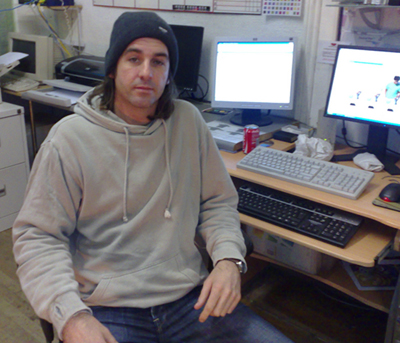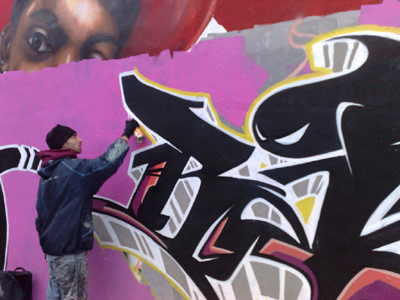Watch this first!
Vodpod videos no longer available.
In October 2008, Cardiff Council drew up its draft graffiti policy in which it published its aims to cut graffiti across the city by way of a ‘Graffiti Busting Unit’. It is keen however to work with residents and associations by displaying murals and public art in specific locations.
Famous graffiti artists such as Banksy have brought the form very much to the forefront of the public eye, but some people will dismiss its artistic merits at all.
Scrawling your name on the side of a phone box may require little thought and take seconds to complete, but a ‘piece’ can take hours or even days to plan and paint. One city artist, Skot , sees graffiti as an artform just like any other, and fails to understand "how people can think any different – sure, it may not to be your taste, but that doesn’t mean it’s not art."
M![]() ost artists will start painting illegally. Keiron Jones, owner of Castle Street’s Oner Signs , a sign-making, graphic design and graffiti shop, points out that as artists "get into graffiti, they get into tagging, bombing and doing pieces. They’re going to do that illegally to begin with, as they get older, maybe some of them get arrested and they then have jobs, they have mortgages, they have kids – sometimes, dare I say it, they might have to grow up slightly."
ost artists will start painting illegally. Keiron Jones, owner of Castle Street’s Oner Signs , a sign-making, graphic design and graffiti shop, points out that as artists "get into graffiti, they get into tagging, bombing and doing pieces. They’re going to do that illegally to begin with, as they get older, maybe some of them get arrested and they then have jobs, they have mortgages, they have kids – sometimes, dare I say it, they might have to grow up slightly."
One of the most talented artists painting in the city, Rarebit (real name Craig Jenkins) from Port Talbot confines his work to legal walls such as Elm Street Lane in Roath. When he was younger and "didn’t really know what [he] was doing" Craig would go out with the intention of painting illegally, but finds that the legitimate walls are now more suited to "turning up and painting all day. You know, take your time, have a laugh more than getting all paranoid."

Aside from the wall in Roath, there are two more main legal graffiti sites; Seven Oaks Park in Grangetown and Hailey’s park in Llandaff. Skot believes "Cardiff’s pretty good for legal spaces, it’s probably one of the best in the country." Even so, most artists would like to see even more provision of legal spaces. Says Keiron Jones, "You go to any other European city and you’ve got a hell of a lot more legal sites than you have in Wales."
Artist Skroe thinks he might just have the solution for the shortage of spaces "When they’re putting up buildings around the city, why don’t they let us paint the wooden hoardings around the sites? Makes everyone happy then."
Another way painters can get involved in the graffiti scene is by attending a festival or a jam. Seven Oaks Park’s RoxeJam was set up in 2007 in memory of a young graffiti artist who was tragically killed in a road accident. Music, DJing and breakdancing also take place at the yearly event, and is described by Skroe as "a great positive success – a good day out."
Vodpod videos no longer available.
This element of graffiti culture can help who Rarebit describes as "troubled kids". He runs graffiti workshops in his local area and believes it provides them with "something they can get into because it’s got a bit of a street cred." Anna Fruen , a local fan of Cardiff’s graffiti pieces considers that workshops are "a great way of opening up an art form and a subculture that could help give some sense of identity." She explains further "I wish there’d been graffiti workshops for people like me growing up."Skroe, a former heroin addict, has first-hand experience of graffiti helping him to kick a dangerous habit. "After seeing my best mates, true friends in my crew painting fresh pieces, I had to stop [taking heroin]. Graffiti got me back on track."
Banksy may have brought artistic graffiti to the attention of the public en masse, but amongst some graffiti artists and fans he is not as popular. Anna Fruen believes he is a "wonderful representative of graffiti" but worries that "nobody else seems to be getting any press" because of his notoriety. Skot is frustrated by mixed messages in the media,

"People like Banksy get hyped and are getting big bucks for their efforts, whereas artists like the DMP crew get jail time for theirs."
Although the council and residents’ associations may be doing a good job of providing legal spaces for artists in the city, there will undoubtedly always be an element of illegality about the scene, as Keiron Jones says, "That is what keeps the thing going."
Keiron Jones feels that Cardiff has some of the best writers in the UK, as legal walls begin to grow in popularity and accessibility, perhaps we might find the next Banksy right here in our local area?
The map below shows a small selection of both legal and graffiti sites around Cardiff. The purple pins demonstrate illegal graffiti sites, the green pins show legal walls. Click on the pins for descriptions and pictures where available.
Thanks to all the people that helped me with this piece, Rarebit, Anoy, Oner Signs and Keiron Jones, Skot, Daniel Escorcio, Skroe, Anna Fruen, Cardiff Graffiti and Street Art Flickr Group and anybody I might have missed out!
That’s great! You really did your research with this one! I’m gonna have to head out to the other legal walls at some point, I’d love to see what else is going on. Thanks for using my quotes, haha I feel helpful now!
x
Just passing by.Btw, you website have great content!
______________________________
Don’t pay for your electricity any longer…
Instead, the power company will pay YOU!
A great article, I’m currently conducting some research at uni on attitudes towards graffiti and your piece really helped, thanks!
Neat page=D Will come back again soon=)
Gute Seite! Dieser Post ist interessant. Danke dafuer.
Thanks a ton for this, I am greatful for the info